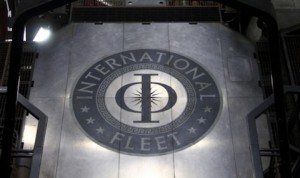Production Underway on “Ender’s Game”
Posted on May 30, 2012 at 8:00 am
 Orson Scott Card’s sci-fi classic Ender’s Game
Orson Scott Card’s sci-fi classic Ender’s Game is the story of a gifted child who is taken from his family at age 6 so that he can be trained to lead the Earth’s military forces against “bugger” aliens who have twice attacked our planet. The winner of Hugo and Nebula awards, the book has been a classic since it was first published in 1985 and speculation about a possible movie version began almost immediately. It’s finally happening with writer/director Gavin Hood (“Tsotsi”) and scheduled for release in November 2013 with Harrison Ford as Commander Graff, “Hugo’s” Asa Butterfield as Ender Wiggin, and Abigail Breslin will play Ender’s sister Valentine. Cinema Blend has some intriguing details about the “Ender’s Game” production courtesy of producer Roberto Orci. Everyone is curious about
how the film team would be “approaching the great deal of wonderful internal monologue.” It becomes pretty clear in the book that Ender isn’t a big talker. He’s a thinker (and a really good one), and he also proves to be especially emotional and empathetic, which affects the choices he makes as a budding leader and among his peers. A big part of what makes the book so great isn’t merely seeing what Ender does, it’s understanding why he does it and how he makes his choices. Not all of that is expressed through dialogue, so this is a really good question. And Orci has a really good answer to go with it. It starts with a muppet…
“We have a muppet of the Colonel who narrates the whole thing from the future. Oh, no wait, different movie. I joke because that is a great question and I think Gavin would tell you that it was the biggest challenge he faced in composing his script. It was also the most challenging aspect of the casting process. So here we have two things that really make it happen. First, we got such an unbelievable group of actors who can convey so much with their faces and body language… frankly, with their performances, which is something a book is denied using to convey inner emotion or thought. And secondly, of course, Gavin elegantly translated some of the inner thought into action or character decisions in his script — drama — and that allowed him to find natural places for the characters to speak about what they are going through.”

